Criticism causes students to rethink cultural clothing choices
Evelina Gaivoronskaia | Staff Writer

Amidst comments and criticism from others, students attempt to balance their culture with their self expression
From food to language to clothing styles, culture can be a big part of students’ identities. Some often face the tough decision between changing their style to fit into their cultural expectations or having to withstand negative comments about their style and choice in clothing.
Junior Areej Khan identifies herself as a Muslim and is part of the Desi community, which generally refers to people from South Asian countries. She has experienced remarks about the way she dresses from friends, relatives, and even strangers.
Khan said that one of the incidents that stuck out to her was when she wore a skirt to school and a student commented on her attire. The student asked if she was Muslim, and Khan confirmed that she was, but explained that it was her choice to wear what she wanted.
“They just assumed that just because I’m Muslim, I needed to start covering up,” Khan said. She says that although some Muslim
women choose to dress more conservatively and cover their hair,
her own clothing choices do not invalidate her commitment to her religion.
Khan has also encountered criticism at social and cultural events. Since Khan does not own a plethora of cultural clothes, sometimes she will wear more Western clothing to these events. In response, people comment on her outfit, saying that it does not fit into the setting because it is too Western. Khan said that most of the time she is told that she “should probably be wearing [traditional] clothing.”
As she grew up, Khan began to embrace her culture more. She describes herself as “a lot more conservative and Muslim”. Over the years, she decided to dress in more culturally appropriate clothing to go to parties.
Khan says she “started loving [her] culture a lot more recently” and tries to immerse herself in it more. With that decision came the problem of finding the clothing that not only fits her personality, but also fits into the standardsfor Muslim women. Khan finds that the hardest part of her experience has been “trying to balance [her] self expression and [her] culture.”
Junior Hannah Scholes has
experienced a fair amount of negative comments about her clothing
choices. As a Catholic, she said that most of the criticism comes from her parents and grandmother. The comments are usually a criticism on how she is “showing too much skin,” Scholes said.
Scholes said that she hears negative opinions about her clothing about once a week, and when she does it makes her feel “violated and embarrassed”. At times, in order to avoid the comments, Scholes tries to change her style and dress in a more conservative fashion, because she realises that people often view her based on how she dresses. She said she always comes back to the clothing that makes her feel happy and expresses her own unique style and preference.
Junior Laila Shaikh, an Arab American, has also experienced negative feedback from both of her cultures. She wears a hijab and loose clothing that doesn’t expose a lot of skin. Shaikh is no stranger to comments from the peers, adults, and strangers around her. She said that her biggest struggle is balancing her cultures and not leaning into either of them too much. She notices that she gets negative feedback from both
Americans and Arabs regardless of how she dresses, and that parts
of her identity “don’t go together
sometimes because [she will] always get negative feedback.”
Shaikh recalled an incident where she and her mother went to a store in order to pick up supplies for a party in their traditional clothes. As they were shopping, a man started to yell insults about their clothing at them. The experience stuck out to her because she did not understand what had upset the man, since she was “literally just [wearing] a piece of clothing,” Shaikh said.
Although moments like that one used to hurt Shaikh’s feelings and even made her want to dress in more American ways, she decided to immerse herself more in her culture and “become very passionate about it and own up to it”.
Shaikh tries her best to incorporate both Arabic and American ways into her clothing in order to express herself fully. She says it can be challenging for her to do so, because she tried to lean into both cultures equally.
“Trying to not overly step into one culture or another is pretty complicated,” Shaikh said. “It is a never ending self identity process.”
